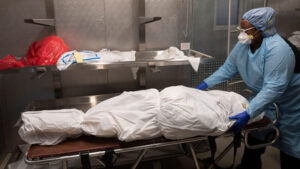The new organization reported in a statement on Monday, “CDC tends to conclude that individuals, based on present science, are more likely to be infected longer and closer to a human with COVID-19.”
The current update recognizes that some recorded reports indicate a small, unusual situation when COVID-19 infected people are more than 6 feet away or soon after the COVID 19-positive individual leaves the region.
“Transmission has happened in poorly ventilated and confined environments, in which practices such as music or training have been regularly carried out.
“These conditions and behaviours might lead to the growth of particles that carry the virus.”
The Agency amended its guidelines last month to suggest that COVID-19 could disperse throughout the air, and then returned to its prior policies days unexpectedly later.
At the point, the department claimed it had erroneously released a draught version of the planned amendments, and the revised wording will be issued until the technical review period is finished.
CDC suggests that by keeping 1,8 m far from the others, with a mask protecting their nose and lips, washing their hands regularly, brushing the surfaces, and remaining home if they’re ill, they will shield themselves from coronavirus.
The introduction first identifies coronaviruses’ development and then the appearance, propagation, effects, prevention, and treatment of COVID-19, this summary is structured. In non-US health care environments, the majority analyses COVID-19 IPC goals.
History of coronavirus:
Coronaviruses are a complete family of animal or human disease viruses. Many recognized coronaviruses triggering breathing infections exist in humans. This coronavirus varies from frequent cold to severe diseases like significant acute respiratory syndicate (SARS), a respiratory syndrome in the Middle East (MERS), and COVID-19.
COVID-19 is attributable to the extreme coronavirus 2 (SARS-CoV-2) acute respiratory syndrome virus, a modern human virus that can transmit from person to individual, causing respiratory illness. Many patients recorded having ties with a broad market on aquatic goods and lived animals early in the epidemic; however, later on, the disease had not been confirmably transferred personally to the market. Furthermore, there was a travel-related export of events.
Transmission: Respiratory droplets often transfer COVID-19 from person to person. These outlets arrive while someone is sneezing, crying, or communicating with COVID-19. The mouths or noses of close or probably inhaled people in the lungs may contribute to contagious droplets. The World Health Organisation (WHO) recommends preventing contamination at least one meter physical distance (3 ft), even if the several WHO Member States have proposed that greater distances should be preserved wherever possible. Respiratory droplets may fall around the person on hands, items, or surfaces as they toast or speak.
COVID-19 will then affect individuals by touching hands, objects, or droplet surfaces and then touching the eyes, nose, or mouth. The latest literature indicates that COVID-19 may be spread via outlines from individuals with moderate to adverse symptoms2. Present research does not help SARS-CoV-2 long-range aerosol transmission, including measles or tuberculosis. Aerosols should be inhaled rapidly, as for several respiratory toxins, with COVID-19.
However, this cannot be differentiated conveniently from the “droplet” epidemiologically-based propagation. In particular, in cramped medical centers and inadequately vented rooms, short-range transmitting is possible3. Any healthcare operations can contain fine aerosols, which should be prevented when necessary.
Conclusion: The incubation period is projected to be 2 to 14 days for an average of five days. It is .essential to remember that certain people get sick and have no signs or feel unpleasant.





